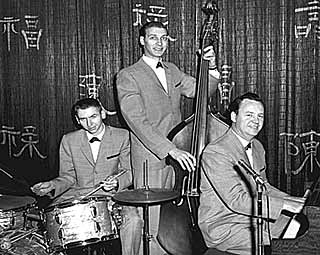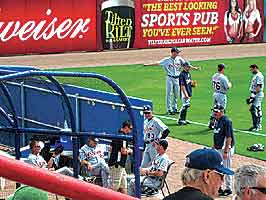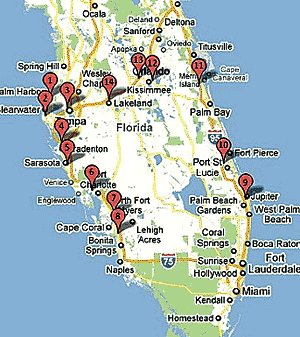

|
V9N11
- Mar. 29 - Apr. 18, 2011:
The year
was 1956. The place was Tec Voc High School. This was when
and where Owen Clark, now a highly accomplished Winnipeg musician,
had his first taste of being on stage. It all happened “quite
by accident” as Owen recalls, when the original drummer
for the school’s production didn’t show up. “I
was attending Tec Voc , and a couple of guys that I knew quite
well were in Army Cadets and were both drummers... and they
were supposed to play a bass drum/snare drum routine behind
a baton twirler named Diane Biggar, and when the time came,
the snare drummer didn’t show up! The bass drummer, who
was also a snare drummer, jumped over on snare drum and said
“Here! Play bass drum!” So I did, and we just did
the act.” And that
initial gig left Owen saying to himself “Hmm, I need
to do more of this!” And so he did. About
Owen If the
name Owen Clark is unfamiliar to you, here’s a little
breakdown: He’s
a drummer, percussionist, vocalist, bass player, composer/arranger,
historian, author, radio announcer and programmer. He’s
earned a Bachelor of Music Education and a Licentiate Diploma
in Performance (High Distinction in Percussion), as well as
a Master’s of Science in Education (Major in Music).
He currently performs with the Owen Clark Band, the Owen Clark
Big Band, and the Owen Clark Jass Group, in addition to freelancing
with numerous other bands, singers, and performing groups
in the Winnipeg area. He was also the honoured recipient of
Jazz Winnipeg’s 2009 Manitoba Jazz Musician of the Year
Award. Owen is
also a husband and father of five. The
Early Years Born in
Winnipeg in 1938, Owen spent his first ten years in Saskatchewan
before heading back to the River City, where just eight years
later, he would begin his musical journey. Besides
his grandmother, who was a church organist, Owen was the first
of his family to pop up into the music world.
His parents
encouraged him but were not musically inclined themselves.
“Music was in the house, as it was when you were growing
up in the 40’s and 50’s, because the radio was always
on. And radio in the 40’s and 50’s was a little
like CJNU.” (A station Owen is currently involved with
as an announcer as well as head of the programming committee)
“It was very eclectic. So you’d hear all kinds of
stuff growing up! And it stays with you!” And indeed
it did. Although
his earliest musical memory was being part of a student choir
and singing Christmas Carols, Owen’s actual decision
to become a professional musician happened in the late 50’s
when he was invited to join a country band. They were to head
out on the road, so to take the gig, he’d have to quit
his day job. Owen accepted the offer, and has been playing
music ever since. The
Beat Goes On When asked
what his single biggest musical accomplishment has been, Owen
had this to say:
“The
fact that I’m 72 years old and I’m playing better
than I ever was, I’m writing better than I ever was,
so I guess for me, age has been a plus, and not a downside.” And I’m
sure friends and fans alike would agree that, like a bottle
of fine wine, this multi-talented individual just keeps getting
better with age! Influences Owen’s
list of inspirations grew and changed over the years. Drummer
Gene Krupa was his first and biggest influence. He later took
lessons with a Winnipegger by the name of Eddie Sersen, who
was the city’s Krupa according to Owen because “he
kind of even looked a little bit like Gene, and certainly
played like him, with the same kind of flash and excitement
and speed!” As Owen
grew older, he became influenced by a different style of drummer-
Jimmy Cobb with Miles Davis, Shelly Manne and his group, Louie
Bellson, and Jo Jones with the Count Basie Big Band. “That
was probably it for influences early on, my influences changed
a lot when I went to University because the University’s
teaching was classical, not jazz, and I started to hear and
understand a whole lot of music that I hadn’t spent much
time with, which was classical and opera.” Words
of Wisdom Aside
from great influences and diverse musical exposure to aid
in Owen’s success, when asked what his most valuable
lesson learned was that would help him thrive in the music
business, Owen replied “I guess it would be that musicians
in general are hired to play music to please a client, and
if you insist on playing music to please only yourself, you’re
probably not going to work very much!” Probably
a good lesson in humility and keeping your feet on the ground,
a charming quality to hold onto tightly amidst rising fame
or notoriety. Further
to these wise words, I asked Owen what advice he would have
for today’s aspiring musicians. “That’s
a very difficult one because the musical world that I grew
up in no longer exists. We’re now in an age of electronic
drums and computers and the way that music is sold and distributed
now on the internet...you can put a piece of music up on You
Tube and be around the world in 30 seconds or less! So I really
can’t answer that; I can’t really give a young person
now that kind of advice. They have to find their own way much
the same as I did, I guess. And in some ways it’s easier
because of the digital communication that we now have, and
in some ways it’s harder because the competition is incredible;
it’s world-wide competition now, not local like I grew
up with.” Current
Projects One of
Owen’s latest projects was “Blues in Winnipeg Prior
to 1960”- a presentation he recently did at Aqua Books,
which took a look back at the history of Blues in Winnipeg
before 1960. The project came about while Owen was creating
shows for CJNU. While looking through the repertoire, he realized
there was really no information about the Blues in Winnipeg
until roughly the 60’s, and was curious as to what happened
before that. So, he began compiling sample radio shows and
thought “well, we’ve got all kinds of stuff here
that includes Winnipeg musicians, so why not do a presentation
on it and see how it flies! See how much interest there is!” Discussing
this project brought on some curiosity as to the details of
Owen’s own role in the Winnipeg Blues scene. “I’ve
played with Blues bands but I’ve never really focused
on just playing Blues. However, if you play Jazz, which I’ve
done all my life, then Blues is a big part of that.” Owen’s
newest and biggest project is “The Book of Vaudeville”-
a movie being filmed by MTS Television Winnipeg on Demand
and Far Point Films. Owen is Musical Director and his band
will be featured in the film. In fact, the opening song of
the film was written by Owen and titled,
“Orpheum Cakewalk.” The initial conception
of the movie came from a scrapbook which friend Gene Shelley
had found and given to Owen, dating back to the 1920’s,
all about the old Orpheum Theater in Winnipeg. This scrapbook
also helped in his research for his book “Musical Ghosts”-
a wonderful history of Manitoba’s Jazz and Dance Bands,
published in 2008. Incidentally, the scrapbook is now at the
City of Winnipeg Archives. “The
film company picked up on the scrapbook and decided that they
could actually create a film out of it, and so at 7 pm on
April 14th, we’re doing a free concert at the Pantages
Playhouse Theatre. If anybody wants to attend they are quite
welcome! We have 900 seats to fill and the only thing people
have to realize is that we are shooting a movie, so you may
get to see the same act or hear the same tune twice because
we just decided to do a retake! But I do encourage everybody
to come down!” You can
contact Owen for tickets by calling 275-0894, e-mailing
him at drumjazz@mymts.net,
or find him on Facebook. (Read
more in the March
29 - April 18/2011 issue of Senior Scope) Social Networking and Internet Safety:While
many Canadians enjoy the benefits of social networking, some
are learning the pitfalls of failing to adequately protect
their personal information. If you publish personal information
online you’re potentially exposing yourself to a world
wide audience and become vulnerable to Identity Theft. Complaints
of social networking hacks and account takeovers are common
but avoidable if you follow the security guidelines provided
by your social network. Incorporating the following tips can
ensure greater protection while on the Internet: •
Use strong passwords which are a minimum of 8 characters long
and include capitals, numbers, and special characters. Avoid
dictionary words, pet names, birthdays, phone numbers, maiden
names, and addresses. •
Change your password every 2-3 months •
Adjust the privacy settings and restrict access on your social
networking account •
Keep your operating system, web browser, and other software
up to date to protect from identified vulnerabilities •
Use and maintain anti-virus software By applying
simple Internet security practices and managing your personal
information wisely, cautiously, and with an awareness of the
issue, you can prevent becoming a victim of Identity Theft. Cst.
Ben Doiron (Read more in the March 29 - April 18/2011 issue of Senior Scope) Financial Planning:It’s okay to“double-dip”BRIAN
G. KONRAD CFP, Financial Consultant Help
secure your family’s future As a parent,
you have to be a terrific juggler. You juggle time to complete
all the tasks and chores that fill your day. You juggle responsibilities
to ensure your children have the best possible childhood and
prospects for their future. Yet the toughest juggling act
of all is managing your finances while raising a family. It
can be even more difficult to find the extra dollars needed
to invest towards a comfortable financial future, including
your retirement and the educational plans of your children. If you’re
a parent of young children, you are probably struggling with
a tough decision: Is it better to first save for your retirement
through Registered Retirement Savings Plans (RRSPs), or to
save for your children’s education through Registered
Education Savings Plans (RESPs)? Fret no
more because there is a way to do both: Make your RRSP Here’s why the ultimate “double-dip” works so well: •
When you make your maximum allowable RRSP contribution you
may enjoy tax-savings that can be applied towards establishing
or adding to your children’s RESPs. •
The federal government’s CES Grant program provides a
matching grant for each RESP contribution made for an eligible
child. The Basic CES Grant is worth 20% on the first $2,500
of an annual RESP contribution or $500 per year. This eligibility
accumulates and carries forward, so even if you were unable
to make enough of an RESP contribution to access the full
Basic CES Grant money in previous years, you can start to
make up for it now and in future years and get the Basic CES
Grant money your child would have received in those earlier
years. •
Families with children born after December 31st, 2003 who
also receive the National Child Benefit Supplement may also
qualify for additional funds through the Canada Learning Bond.* Start
now Finding
the funds to make an annual RRSP contribution may seem difficult
– especially, with all the daily juggling going on in
your life. So why not start now? Talk to your Investors Group
Consultant about setting up a Pre-Authorized Contribution
(PAC) to make monthly RRSP contributions. Your RRSP will begin
to compound on a tax-deferred basis for a potentially fast
and stronger growth over the long term. You can even arrange
for your employer to reduce withholding taxes at source based
on your RRSP contribution schedule, so that you can fund monthly
RESP contributions instead of waiting for your tax refund
in the spring to make an annual RESP contribution. It’s
a win-win situation that will allow you to also capitalize
on the ultimate “double-dip”. Let us
help you feel more confident about your future – plus
make sure you take full advantage of all the tax-saving and
income-building opportunities that are available to you. BRIAN
G. KONRAD CFP Written
and published by Investors Group as a general source of information
only. It is not intended as a solicitation to buy or sell
specific investments, nor is it intended to provide tax, legal
or investment advice. Readers should seek advice on their
specific circumstances from an Investors Group Consultant. *The Canada
Education Savings Grant and Canada Learning Bond (CLB) are
provided by the Government of Canada. CLB eligibility depends
on family income levels. Some provinces make education savings
grants to their residents. ™Trademark
owned by IGM Financial Inc. and licensed to its subsidiary
corporations. “It’s
okay to “double-dip” © Investors Group Inc.
2010 (04/2010) MP1262 (Read more in the March 29 - April 18/2011 issue of Senior Scope)
|
|
Back to top We All Deserve a Barrier-Free Manitoba. Accessibility Shouldn't be Optional.- The Push for Provincial Legislation By Hilary GrammerBy Hilary Grammer Accessibility
is basic to the quality of life of all Manitobans. Seniors,
unlike many Manitobans, cannot take accessibility for granted.
The design and conditions of our streets and sidewalks, even
our parking lots, make it hard for many seniors to get around
their communities. Many of our buildings are hard for seniors
to get in and out of. Likewise, basic services ranging from
transportation to snow clearing and even information in print
or on the web often seem designed to meet the needs of healthy
35 year olds with perfect hearing, sight and mobility. As the
bulge of baby boomers reach retirement age, accessibility
is going to become an issue for more and more seniors. The
numbers are undeniable. In 2006, an estimated 71,000 to 77,000
Manitoba seniors faced accessibility challenges due to a disability.
By 2031, the number facing such challenges is expected to
double to almost 150,000. Our population
is aging – and the incidence of various disabilities
increase with age. Patrick Falconer, spokesperson for Barrier-Free
Manitoba (more on that organization later), addressed what
this means to us all, saying that, “every Manitoban now
has a disability, knows someone with a disability or will
acquire a disability in the coming years.” Recent
surveys completed by 1,100 persons concerned about seniors’
issues in 46 communities across Manitoba clearly identified
accessibility issues related to •
Housing It is
easy to understand how these everyday features in our community
can either lend themselves to easy, pleasurable participation
in friendships, community events, shopping, appointments and
entertainment – or, conversely, chip away at a senior's
ability or desire to go where s/he wants or needs to go, to
receive the information s/he wants or needs to receive, and
– most importantly – to feel comfortable in his
or her community. There
are two major efforts underway to address accessibility issues.
One
of these is the Age-Friendly Manitoba Initiative (www.gov.mb.ca/shas/agefriendly),
led by the provincial government's Seniors and Healthy Aging
Directorate in partnership with community groups. The Age-Friendly
Manitoba Initiative supports seniors in leading active, socially
engaged, independent lives that contribute to healthy aging.
Barrier-Free
Manitoba`s web site (www.barrierfreemb.com) provides more
information on these findings. While
both these efforts are making progress, the work of Barrier-Free
Manitoba has now reached a critical juncture. Progress
Toward Accessibility Legislation Over the
last 2 1/2 years, Barrier-Free Manitoba has not only raised
awareness about accessibility issues, but its call for legislative
change has been endorsed by such prominent Manitobans as Dr.
Paul Thomas, Reg Alcock and John Loxley and by a diverse range
of organizations and agencies including groups like: •
Age & Opportunity The call
for legislation has also been endorsed by hundreds and hundreds
of concerned Manitoba citizens whose lives have been seriously
affected by the lack of accessibility in their communities. In November
of last year, the Government of Manitoba released the Discussion
Paper for Made in Manitoba Accessibility Legislation. The
purpose of the paper was to encourage discussion on proposed
legislation that would move our province toward the goal of
an inclusive society. As had been called for by Barrier-Free
Manitoba, the legislation being considered would set out a
process for elimination of “the institutional and physical
barriers faced by seniors and persons with disabilities"
and the "prevention of new ones". The paper also
stated that “increased accessibility also promises to
provide significant economic benefits and will support Manitoba-based
businesses in better meeting the growing demand for accessible
products and services." The good
news for Barrier-Free Manitoba, and the many that support
the call for legislation, is that The Province of Manitoba
seems poised to introduce this landmark legislation. The bad
news is that there is only one sitting of the Legislature
left before the upcoming fall election. As Falconer stresses,
"this is an amazing opportunity but if the government
does not act this spring – before the next election –
it may be years before we have the same chance again.” The
Final Push – Making it Happen With the
cooperation of seniors' organizations across the province,
Barrier-Free Manitoba is mounting a final push to ensure that
the Government of Manitoba moves beyond promising words when
the last sitting starts on April 12th. The centre
point of the final push campaign are action post cards that
Barrier-Free Manitoba is inviting seniors and those concerned
about seniors issues to send to the Premier's office. Key
statements on the cards read: •
The Government of Manitoba needs to play a much stronger role
in ensuring the timely removal of the barriers and in creating
accessible and age friendly communities. Manitoba’s
seniors and those who care about them and provide services
to them have historically had a strong voice in Manitoba.
This seems to be a perfect opportunity to use this voice again in a way that will benefit all Manitobans now and in the years to come (Read
more in the March
29 - April 18/2011 issue of Senior Scope) There is Nothing Better Than Spring Training Baseball to Get Away from the ColdBy Scott Taylor
LAKELAND,
Fla. – It’s hard to imagine there is anything better
than this on the planet: You’re sitting in a beautiful
little ballpark just like Shaw Park in Winnipeg, only it happens
to be a warm March day. You have a nice cold beverage, a tasty
hotdog with some nachos and plenty of cheese, good friends
and there’s Magglio Ordonez and Miguel Cabrera hitting
back-to-back home runs against the hated New York Yankees.
Well OK,
it might not be perfect for Yankees’ fans but they can
have their own fantasy. We like ours, thank you. And so
do hundreds of Manitoba seniors who make the trek every year
– or every other year – to Grapefruit League Baseball
in Central and Western Florida.
“I
love baseball. There is nothing I love more,” said Tom
McClusky, 73, who spent a life in sales in Winnipeg before
retiring. “I
always wanted to go to Spring Training, all my life. Ever
since I read about it in the Sporting News when I was a kid.
I got my first chance 1976. We took our two daughters to Florida
and I saw four games. The first Grapefruit League game I ever
saw was in Vero Beach where the Los Angeles Dodgers used to
be. I’ll never forget it. Then we saw two Cincinnati
Reds games in Sarasota and then we saw the Orioles against
the Yankees in Miami. “I
absolutely loved it, but I didn’t get back until my wife
and I went to Arizona three years ago. Next year, we’re
already planning our trip to Spring Training in Florida.” Interesting.
The 2010 Grapefruit League season has just wrapped up and
yet Tom and his wife are already preparing for 2012. “Well,
we’re going to go to baseball, definitely,” he said.
“But there are a lot of other things to do. I’m
even going to apply to be a volunteer at Arnold Palmer’s
(PGA Tour) golf tournament, the Bay Hill Classic. There is
a lot more to the trip than just baseball.” Tom’s
got that right. When you consider all the casinos, the great
beaches, the theme parks, resorts, golf courses, racetracks,
hockey teams, basketball teams, hiking trails, shopping malls
and restaurants, there is never a dull moment on the Florida
spring baseball trail. Spring
Training in Florida is called the Grapefruit League. It’s
not a league really. It’s a just a month long series
of games in which the stars of Major League Baseball –
along with the fresh-faced kids and aging veterans –
either get ready for the regular season or try to win that
first or last job. The games
begin around February 25 and last until the final week of
March (this year’s regular season started on March 31). There
are 15 teams in Florida: the Atlanta Braves are at Disney
World at Lake Buena Vista, Boston and Minnesota are in Fort
Myers, the Yankees are in Tampa, Philadelphia is in Clearwater,
Detroit is in Lakeland, Baltimore is in Sarasota, Pittsburgh
is in Bradenton, Houston is in Kissimmee, Tampa Bay is at
Port Charlotte, the Mets are in Port St. Lucie, Washington
is at Viera, St. Louis and the Florida Marlins are in Jupiter
and Toronto is at Dunedin. There
are three ways to attack a spring baseball trip depending
on the time you have in Florida. On a short
trip of three or four days, stay in Central Florida and attend
games at Disney (Atlanta), Kissimmee (Houston), Lakeland (Detroit)
and Viera (Washington) or stay in Tampa, or the beach at Clearwater
and attend games in Tampa (Yankees), Clearwater (Philly) and
Dunedin (Toronto). If you
have a week, pick a region. North Central will give you Viera,
Disney, Kissimmee, Lakeland, Clearwater, Tampa and Dunedin.
Southwest will give you Fort Myers (Boston and Minnesota),
Port Charlotte (Tampa Bay), Sarasota (Baltimore) and Bradenton
(Pittsburgh). The East Coast has Jupiter (St. Louis and Florida),
Port St. Lucie (the Mets) and Viera. If you want to stay south,
you can start in Jupiter on the Southeast Coast and then take
the three-hour drive across Alligator Alley to Fort Myers
on the Southwest Coast. Or, stay
for the entire month and catch a game in every park. One of
the best things about the ballparks is that none of them are
far from the four major highways: I-95 on the East Coast,
I-75 Alligator Alley from East-to-West, I-75 on the West Coast
and I-4 across Central Florida from I-75-to-I-95. So now
that you know where you’re going, how do you get there
and where do you stay? Which means the real question is, “What
do I do to get started?” In December,
the Grapefruit League schedule should be announced. Always
keep tabs on www.mlb.com
to make sure you know when the schedule is released and when
the ticket-buying dates arrive. You’ll
need to rent a car and you’ll want to keep an eye on
hotel prices. The beaches can get really pricey in March.
But shop around. Good deals often pop up on the hotel websites
and Disney has some very economical resorts (Pop Century and
All-Star). Now, go
through the schedule and pick the places you want to go. As
an example, we love staying on the West Coast and in Central
Florida. We’ll spend a week at Disney World and watch
the Braves, Astros and Tigers play. Then we’ll go to
Tampa for a night or two to watch the Yankees, then over to
Clearwater Beach to watch the Phillies and Blue Jays and then
down to Sarasota Beach to watch the Orioles and Pirates. We
love beach hotels, tiny ballparks and players who aren’t
all caught up in statistics and pennant races and are ready
to sign autographs, hang out with fans and talk baseball.
It’s pretty loose at spring training and even the big
stars are accessible. (As
an aside, here’s how society has changed. Our 27-year-old
daughter Betsy who lives in Orlando went with us to Sarasota
to watch the Orioles and Minnesota Twins play. She wandered
down to the Twins bullpen and caught the eye of a young relief
pitcher named Anthony Swarzak. While she Googled his career
stats on her iPhone, he threw her a baseball. She then sent
him a friend request on Facebook and not 20 minutes after
the game, he’d already When you’ve
decided how long you want to be in Florida and where you want
to stay, you’re ready to book your tickets. If you go
early in the spring you’ll be able to walk up to most
ballparks and buy a good seat on Game Day. If you go later
in the month, the parks tend to fill up so you might want
to pre-order your tickets. If you plan to attend Yankees games
in Tampa or Red Sox games in Fort Myers, you should always
buy your tickets in advance. The Yanks and Red Sox almost
always sell out. West Jet
has some great direct flights to Orlando and Tampa these days,
but make sure you book early. And remember, when going to
Florida, six-months-in-advance is not that early to make a
booking. And don’t
forget to take your sunscreen and your ball glove. This is
the time of year when the weather is just about perfect and
the players are tossing baseballs into the crowd almost every
inning. “I
love baseball more than anything else,” said Tom McClusky
with a grin. “But I love spring training baseball best
of all.” THE GRAPEFRUIT LEAGUE MAP:
1. Dunedin
– Toronto Blue Jays (Read
more in the March
29 - April 18/2011 issue of Senior Scope) HUMOUR COLUMN: Feline dementia? Or just a cat?
|
|||||||||||||||||||
|
Publisher: Kelly Goodman
Phone: 204-467-9000
Box 1806 Stonewall
Manitoba, Canada
R0C 2Z0
Email: kelly_goodman@shaw.ca









 By
Willian J. Thomas
By
Willian J. Thomas